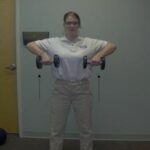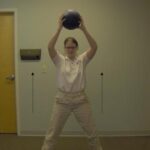There’s a nasty little condition called the Frozen Shoulder Syndrome suffered by a good many people. Formally it’s known as Adhesive Capsulitis, and commonly, it’s the Frozen Shoulder Syndrome and whatever you call it, it is not nice to have.
Frozen Shoulder Syndrome is simply, stiffness and pain in the shoulder joint. The signs and symptoms creep up slowly and then increase. It is understood that the Frozen Shoulder Syndrome lessens after two years. Two years too long.
Prolonged lack of the arm’s use – either by surgical immobilization or even having your arm in a sling heightens the risk of Frozen Shoulder Syndrome.
Experts offer many ways of treating the Frozen Shoulder Syndrome sufferer, but what could be better than the stretch.
The stretch is perhaps the most popular – the one people turn to when hit with the condition of Frozen Shoulder Syndrome. If executed correctly it is A1 treatment for regaining mobility.
A medical adviser with many years of treating the Frozen Shoulder Syndrome warns of patients doing the stretch wrong – therefore I’d love to offer to you, six top stretching tips on Frozen Shoulder Syndrome.
Heat: Moist heat at the commencement of the exercise session. A quarter of an hour of warmth before treatment, opens up the little blood vessels thus allowing an increased flow of blood to the area. It helps relieve the pain caused by Frozen Shoulder Syndrome and also enables all soft and connective tissues to enlarge and increase with the resultant decrease in the chance of being injured whilst stretching.
Massage: What could be better than a soothing massage? This loosens up the muscles, tightened by Frozen Shoulder Syndrome around the shoulder girdle. A good massage using specific techniques increases the effect of the stretching. You can’t do this on your own; you’ll need a partner here. Massaging relaxes you and thus the guarding and tightening of those affected muscles are reduced. Mobility is improved even before you begin to stretch.
Posture: Always a good beginning. Bad posture during the exercises limits your progress. So!
– Head up
– Chin marginally retracted, and of course,
– Shoulders back.
Functional Stretches: Let’s say, for example, you’re finding it hard to get your arm up to the head to either wash of set your hair. Frozen Shoulder Syndrome can cause that. What is needed is to get the tissues in the affected area loosened and lengthened. Perhaps tucking your shirt or blouse is another problem; the same method applies. Stretch with those aims in mind.
Do Not Bounce: Hold the stretch – bouncing reduces the Range Of Motion (ROM). When stretching, you need to take the shoulder from light to medium pain sensation and then hold. Let us emphasise here. DO NOT PUSH PAST PAIN.
Remember to hold and never recoil from a stretch — recoiling never increases ROM, it always reduces it. Take the shoulder from light to medium pain sensation and then hold. And as I said earlier, never push past pain while treating the Frozen Shoulder Syndrome.
Functional Activity: Of course, you want to get back to normal mobile functions again. So, follow all your stretch drills with functional activity in mind. After each session, try placing items just within reach – overhead – into a kitchen cupboard.
These stretching tips for Frozen Shoulder Syndrome have been deemed effective. Of course, there is no need to remind you to consult your medical adviser before attempting any physical exercise program.





